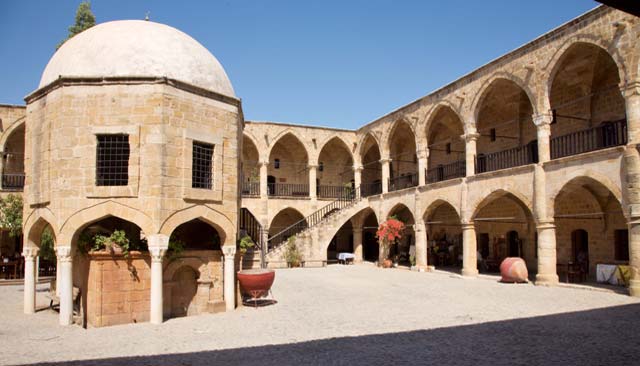Sourp Magar Monastery, Kyrenia Mountain Range
Sourp Magar Monastery is a hidden gem in the Kyrenia mountain range.
St Nicolas cathedral (Lala Mustafa Pasha Mosque) in Famagusta
St Nicolas cathedral isthe most iconic monument in Famagusta, North Cyprus. The cathedral’s construction began around 1300, and it was consecrated in 1923. This is where the Lusignans were to be crowned Kings of Jerusalem, so the cathedral had to be a fitting place. The more decorated style of Gothic architecture developing in France was followed here, and the result was a cathedral almost the twin of the one in the French town of Rheims. The upper parts of the mosque’s two towers were badly damaged during the Ottoman bombardments of 1571 and never repaired. With the Ottoman now in control, the cathedral was converted to a mosque. Visitors can enter, provided no religious services are taking place (small charge). The cathedral is not only the thing standing from the 14th century, the tree by the main door, an African fig, Ficus sycomorus, with leaves like a mulberry tree, is said to have been planted at the same time.
Salamis Ruins, Famagusta
The ancient city of Salamis was founded as an Achean Colony. According to the legend, it was founded by Tefkros, the son of King Telamon, the ruler of the Greek island of Salamis. Since he failed to prevent the suicide of his younger brother, Ajax, during the Trojan wars, after the war his father would not permit him to enter the country. He landed on the Karpas peninsula at the place known as Achaion Akte (the Achaean shore) in 1184 BC, accompanied by a band of friends in arms, from the Trojan War, and a group of people who had been taken captive during the war. After having stayed there for a time, he identified the area where Salamis is now situated and founded the city. Salamis ruins include the Roman Gymnasium located at the north extremity of the city; Theatre which was built in the period of Augustus, during the first years of the Roman Empire; Roman Baths made from huge stones; Roman Villa situated to the south of the theatre; Water meter, Granite Forum, Saint Epiphanius Basilica, Water Store, Agora (market place), Temple of Olympia Zeus, and Kampanopetra Basilica.
Karpas Peninsula: Apostolos Andreas Monastery & Golden Sands Beach
Karpas peninsula is one of the most beautiful places in Northern Cyprus. It has some great sightseeing areas and beautiful beaches on the way.Great Inn (Büyük Han), Nicosia (Turkish: Lefkoşa)
The Great Khan is found to the southwest of Asmaaltı Square, Lefkoşa's traditional commercial centres. It was not only the largest city centre commercial inn in Lefkoşa (Nicosia) but also in the whole of Cyprus. Today, it is one of the only two khans which have survived from Ottoman times and has a privileged place in North Cyprus's cultural history. From 1982 - 2002 it underwent restoration and then opened as a centre for traditional Cypriot handicrafts, where handicrafts are made and sold. It is a two storey building and the open courtyard in its centre is surrounded by diagonal vaulted arcades and vaulted rooms. Great Inn is one of the most visited places in Nicosia.
Soli & Vouni
The origions of Soli reach back to the 16th century BC; it was one of the ten city-kingdoms into which Cyprus was divided at the time. What remains today is mainly from the Roman period. The covered basilica is one of the first covered churches built on Cyprus and is mainly from the 16th century AD. The canopy might add nothing to the atmosphere, but it does protect a floor covered with some wonderful mosaics, especially the swan (on the right). Further up the hillside is a theatre which has been so overly restored that the ancient atmosphere is now lost. The agora lies to the west of the pay booth, but there is little standing above ground level.
Located at 230m (275ft), Vouni Palace certainly offered a room with a view – probably many rooms with extensive views. Its origins are not known with certainly, but the palace is thought to have been built during the Persian occupation in the 5th century BC. There was constant with pro-Athenian Soli nearby. The palace was burnt down in 330 BC and abandoned around 400 BC. Little if its history is know – not even its origin name (vouni just means mountain in Greek). There is plenty to see, and various rooms are well marked.
source: place to visit
 Sourp Magar Monastery is a hidden gem in the Kyrenia mountain range.
Sourp Magar Monastery is a hidden gem in the Kyrenia mountain range.



No comments:
Post a Comment